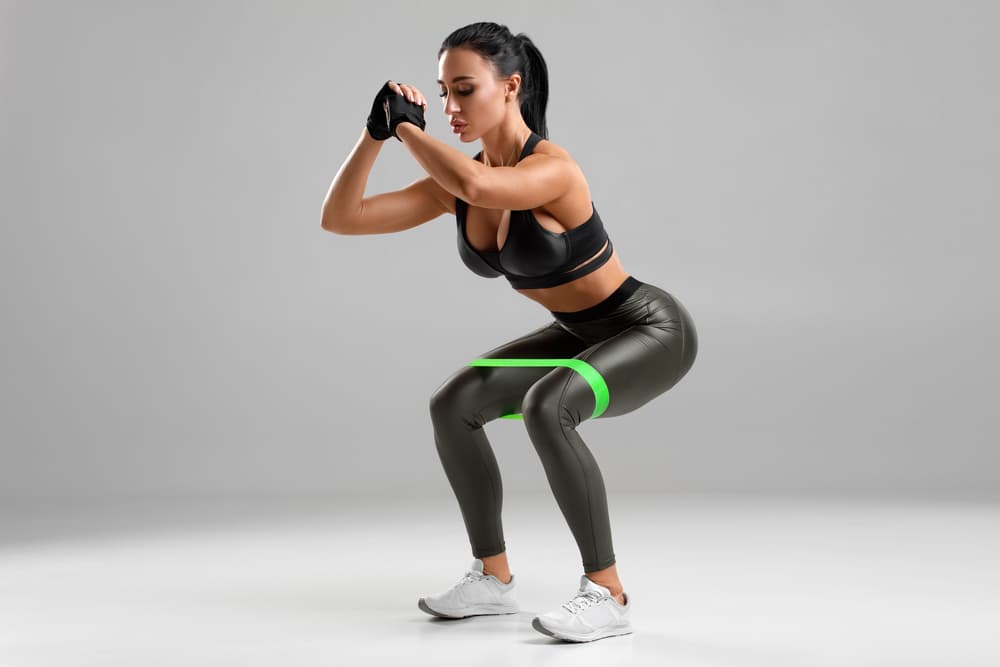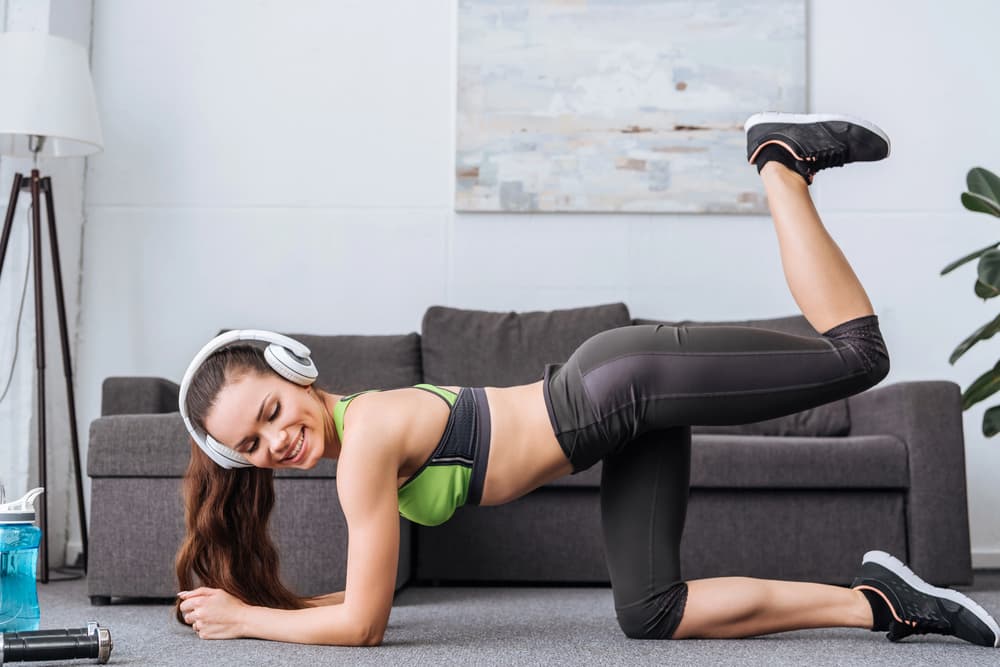An effective glute workout at home includes a mix of compound and isolation exercises.
Compound glute exercises target several muscle groups. Examples are squats, lunges, and step-ups. In contrast, isolation glute exercises target a single muscle group. Examples are glute bridges, leg lifts, and glute kickbacks.
Let’s create an at-home workout with these glute exercises, so you can start training for a shapely butt!
Easy Glute Workout at Home
A comprehensive glute workout starts with a few minutes of warm-up exercises. Next, perform the main workout with compound and isolation glute exercises. Then, end the routine with a cool-down session.
Here’s a workout plan you can use as a guide or inspiration.
1. Warm up for 5-10 minutes.
Prep your muscles and joints for your booty workout at home. Do some simple cardio exercises, then shift to dynamic stretching:
- Simple cardio: brisk walking, jogging, jumping jacks, or jumping rope
- Dynamic stretching: arm circles, leg swings, and torso twists
2. Do your glute workout for 20-30 minutes.
After the warm-up session, proceed to your main glute workout. Ideally, include compound and isolation exercises like the following:
- Squats: 3 sets of 15 repetitions
- Lunges: 3 sets of 12 repetitions per leg
- Step-ups: 3 sets of 10 repetitions per leg
- Glute bridges: 3 sets of 20 repetitions
- Leg lifts: 3 sets of 15 repetitions per side
- Glute kickbacks: 3 sets of 15 repetitions per leg
Adjust the number of sets and repetitions of each exercise to match your fitness capacity and available time. Also, scroll down to learn how to do these booty exercises at home.
3. Cool down for 5-10 minutes.
Cooling down after your glute workout lowers the heart rate back to normal and reduces muscle soreness. For this routine, perform cool-down stretches meant for the butt. Here are some examples:
- The figure-four stretch targets the glutes and outer hips. Start by lying on your back. Then, cross your right ankle over your left knee. Next, gently pull your left leg toward your chest until you feel a stretch in your glute.
- The seated forward fold stretches the hamstrings and glutes. Start by sitting with your legs extended. Then, reach for your toes or shins while keeping your back flat and hinged from the hips.
- The child’s pose targets the lower back, glutes, and hips. Start by kneeling on the floor and sitting back on your heels. Then, drop your chest forward, resting your forehead on the floor.
Best Glute Exercises for Home Workouts
Here’s a how-to guide for the glute exercises included in our workout. Be sure to perform them correctly for optimum benefits and safety.

1. Squats
- Start by standing with your feet hip-width apart.
- Step your right foot wide to one side, then bend your knees to come down to a squat position.
- Hold this pose for a few seconds, then stand and bring your foot back into the starting position.
- Repeat this action up to 15 times before switching to your left foot. Then, do this for about 2 to 3 sets on each side. You can also do this alternately if you like.
Variations: Make this butt exercise challenging by wearing a light-to-medium-tension loop band above your knee or holding a kettlebell.
Squats, in general, are among the most effective exercises for toning the glutes. And you can always do half or full stationary squats to shape your butt if you like.
For other squat variations, check out this article on how to do goblet squats correctly.

2. Lunges
- Start by standing with your feet hip-width apart.
- Next, step your right foot forward longer than a walking stride. Keep your left foot back with its heel slightly up.
- Then, lower yourself and bend your knees to about 90 degrees. Rest your hands on top of your front knee.
- Hold this position for a few seconds while keeping your chest upright and core engaged.
- Press your left heel to stand, returning to the starting position.
- Repeat this action up to 12 times before switching to your left foot. Then, do this for about 2 to 3 sets on each side. You can also do this alternately if you like.
Variations: One good lunge variation is the reverse lunge, where you step your leg to the back instead.
You can also hold dumbbells in each hand to make this glute exercise more effective and challenging.
Lunges, however, are not advisable if you have knee problems. But you can try these alternative exercises for a bad knee instead.

3. Step-Ups
- Begin by standing in front of a platform, which can be your stairs at home, a sturdy step-up box or an aerobic stepper. It should be high enough, allowing you to bend your knee at a 90-degree angle when stepping up.
- Now, step your right foot up, keeping your left foot on the floor. Next, bend your back knee, if you like, to lunge for an additional challenge.
- Return to the starting position by bringing your right foot down.
- Repeat this action up to 10 times before switching to your left foot. Then, do this for about 2 to 3 sets on each side. You can also do this alternately if you like.
Variations: Step-up exercises work the glutes through single-leg movements. These, in turn, make it easier to activate all three muscles of your butt.
Try using a higher platform or holding dumbbells or weight plates in each hand to make step-ups more challenging.

4. Glute Bridges
- Begin by lying on your back on a mat.
- Bend your knees with your feet about 30 to 40 cm from your butt. Then, place your arms to the side with palms facing down.
- Keep your core tight and push your pelvis up. Squeeze your glutes as you perform this upward motion.
- Hold the bridge position for 2 seconds before lowering your hips back.
- Repeat this action up to 20 times for 2 to 3 sets.
Variations: You can put a loop band above your knees to take your glute bridge to the next level.
Another effective variation of this glute exercise is to hold and place a dumbbell on top of your core while lifting your butt.

5. Leg Lifts
- Start by standing sideways with your feet hip-width apart or lying on your right side with your legs stacked straight.
- Lift your left leg to the side (if standing) or vertically (if lying down).
- Hold the leg lift for about 2 seconds before returning to the starting position.
- Repeat this lifting action up to 15 times before switching to your right leg. Then, do this for about 2 to 3 sets on each side.
Variations: Make this glute exercise even more effective by wearing a resistance band loop around your legs or strapping an ankle weight on one leg.

6. Glute Kickbacks (Donkey Kicks)
- Start by being in a quadruped position. Place the hands underneath your shoulders, knees under your hips, and toes tucked.
- Keep the spine neutral and knees at a 90-degree angle. Then, extend your hip and drive the left heel towards the ceiling.
- Hold the lift for a few seconds, then slowly return to the starting position.
- Repeat this lifting action up to 15 times before switching to your right leg. Then, do this for about 2 to 3 sets on each side.
Variations: Instead of raising a bent leg, try extending your leg to do a straight-leg glute kickback. This move is harder as raising a longer leg length takes more effort.
You can also do cable kickbacks with a cable machine.
Tips for At-Home Glute Workout Success
Follow these tips to keep your workout consistent, healthy, safe, and progressive:
- Aim for consistency: Do at least 2-3 glute workouts weekly.
- Observe exercise diversity: Do exercises that work the glutes at various angles.
- Protect your body: Always warm up and cool down to prevent injuries.
- Master the proper form and breathing: Correctly perform exercises for maximum muscle activation. Proper breathing techniques also enhance performance by improving core stability.
- Rest and recover: Allow at least 48 hours of rest between glute workouts.
- Keep progressing: Gradually increase the reps, sets, or exercise difficulty. Reducing rest periods during workouts also makes the workout harder.
Conclusion
The most effective glute workout is to perform a variety of moves. Combining compound and isolation exercises not only works your butt from all angles. It also makes your routine fun and challenging.
But remember, you are also doing everyday movements like walking that strengthen your bum. So, no need to do glute exercises at home for extended periods, which can lead to fatigue and overtraining.
For best results, 2 to 3 days of glute workouts weekly should be enough. Also, allocate about 48 hours between workouts to let the muscles recover.
Then, keep tweaking your routine. Consider adding weights, using resistance bands, or incorporating plyometrics to spice up your workout.
Related Questions
1. Can an exercise bike tone my bum?
Regular indoor cycling can surely enhance your butt. That’s because your gluteal muscles help extend your hips to perform the pedalling motion. Constant biking targets your glutes and, eventually, makes them less saggy.
2. Can you grow glutes on a treadmill?
Treadmills can potentially flatten your butt rather than enhance it. It is because you tend to reduce body fat with running, which can make your gluteal muscles lose shape. If a shapely butt is among your goals, consider tweaking your fitness routine and ramping up that treadmill incline. Also, try some strategic moves like lunging or walking on a treadmill with bent knees.
- What Is the Best Stationary Bike Workout for Beginners? - 28 November 2025
- What are the Signs of Overtraining in Fitness? - 27 November 2025
- How Does the Yoga Wheel Improve Flexibility? - 26 November 2025
